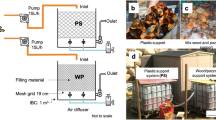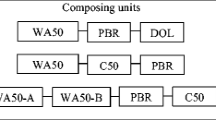Abstract
The Hughes Borehole is located in the bituminous coal region of south-central Pennsylvania and drains an underground mine complex of ca. 2,950 ha. The borehole discharge averages approximately 63 L/s of acidic (pH 4, 230 mg/L acidity) mine drainage that contains elevated concentrations of Fe(II) (100 mg/L). Long-term monitoring of the site showed that biological Fe(II) oxidation occurred without human intervention and, over previous decades, has produced a 0.6 ha iron mound up to 2 m deep. On-mound channel reactors along with laboratory-scale gutter reactors were constructed to determine conditions that can exploit biological Fe(II) oxidation for passive treatment. Dissolved Fe(II) was much more efficiently oxidized from gutter reactors that contained iron mound sediment than ones without any sediment. Close to 100% of the dissolved influent Fe(II) was oxidized in 5–10 h and 75% of the total dissolved Fe was removed. In addition, the reactors performed better as the sediment aged, so that shorter residence times of 1–2 h were also capable of oxidizing substantial amounts of the influent Fe(II). The addition of surface area to the on-mound reactors improved Fe(II) oxidation at residence times of 30 min or less. The results of this study can be used to help design and build treatment systems for low-pH acid mine drainage (AMD) discharges.







Similar content being viewed by others
References
Boyer J, Sarnoski B (1995) 1995 Progress report—statement of mutual intent strategic plan for the restoration and protection of streams and watersheds polluted by acid mine drainage from abandoned coal mines. Philadelphia, PA, US EPA, Appendix, http://www.epa.gov/reg3giss/libraryp.htm
Brady KBC, Kania T, Smith WM, Hornberger RJ (1998) Coal mine drainage prediction and pollution prevention in Pennsylvania. Pennsylvania Dept of Environmental Protection, Ch 4, accessed 18 Jan 2010, http://www.dep.state.pa.us/dep/deputate/minres/districts/cmdp/main.htm
Cravotta CA, Trahan MK (1999) Limestone drains to increase pH and remove dissolved metals from acidic mine drainage. Appl Geochem 14:581–606
Cravotta CA, Brady KBC, Rose AW, Douds JB (1999) Frequency distribution of the pH of coal-mine drainage in Pennsylvania. US Geological Survey WRI Report 99-4018A, vol 1, pp 313–324
DeSa TC (2009) Promoting low-pH biological iron(II) oxidation of acid mine drainage at Hughes borehole: field and laboratory experiments. PhD Dissertation, The Pennsylvania State Univ, University Park, PA, USA, pp 120
GAI (2007) Final report: phase I SRB low mine storage and treatment project evaluation. vol 1, GAI Consultants report submitted to PA DEP Bureau of Mine Reclamation (BAMR), obtained Feb 2009 from BAMR
Hedin RS, Nairn RW (1992) Designing and sizing passive mine drainage treatment systems. In: Proceedings of 13th annual WV surface mine drainage task force symposium, http://wvmdtaskforce.com/proceedings/1992.cfm. Accessed 18 Jan 2010
Jellison KL, Dick RI, Weber-Shirk ML (2000) Enhanced ripening of slow sand filters. J Environ Eng 126:1153–1157
Johnson DB, Hallberg KB (2003) The microbiology of acidic mine waters. Res Microbiol 154:466–473
Kirby CS, Cravotta CA (2005) Net alkalinity and net acidity 1: theoretical considerations. Appl Geochem 20:1920–1940
Kirby CS, Thomas HM, Southam G, Donald R (1999) Relative contributions of abiotic and biological factors in Fe(II) oxidation in mine drainage. Appl Geochem 14:1101–1101
Lucas MA (2008) The comparison of two acid mine drainage sites in central Pennsylvania: field site characterizations and batch reactor experiments. PhD Dissertation, The Pennsylvania State University, University Park, PA, USA, pp 172
Luu Y, Ramsay BA, Ramsay JA (2003) Nitrilotriacetate stimulation of anaerobic Fe(III) respiration by mobilization of humic materials in soil. Appl Environ Microbiol 69:5255–5262
Nengovhela NR, Strydom CA, Maree JP, Greben HA (2004) Chemical and biological oxidation of iron in acid mine water. Mine Water Environ 23:76–80
Nicormat D, Dick WA, Tuovinen OH (2006) Assessment of the microbial community in a constructed wetland that receives acid coal mine drainage. Microbial Ecol 51:83–89
PA DEP (1999) The science of acid mine drainage and passive treatment. Bureau of Abandoned Mine Reclamation, Pennsylvania Dept of Environmental Protection, Accessed 18 Jan 2010, http://www.portal.state.pa.us/portal/server.pt?open=514&objID=588922&mode=2
Rose AW, Bisko D, Daniel A, Bower MA (2004) An “autopsy” of the failed Tangascootak #1 vertical flow pond. In: Proceedings of national meeting of the American society of mining and reclamation and 25th WV Surface Mine Drainage Task Force, Morgantown, WV, USA, Accessed 14 Feb 2010, http://wvmdtaskforce.com/proceedings/04/Final_Abstracts_2004.pdf, p 113
Senko JM, Wanjugi P, Lucas M, Bruns MA, Burgos WD (2008) Characterization of Fe(II) oxidizing bacterial activities and communities at two acidic Appalachian coalmine drainage-impacted sites. ISME J 2:1134–1145
Stookey LL (1970) Ferrozine—a new spectrophotometric reagent for iron. Anal Chem 42:779–781
Stumm W, Morgan JJ (1996) Aquatic Chemistry, 3rd edn. Wiley, New York, pp 683–691
Weaver KR, Lagnese KM, Hedin RS (2004) Technology and design advances in passive treatment system flushing. In: Proceedings of national meeting of the American society of mining and reclamation and 25th WV surface mine drainage task force, Morgantown, WV, USA, Accessed 14 Feb 2010, http://wvmdtaskforce.com/proceedings/04/Final_Abstracts_2004.pdf, p 142
Williamson MA, Kirby CS, Rimstidt JD (2006) Iron dynamics in acid mine drainage. In: Barnhisel RI (ed) 7th International conference acid rock drainage (ICARD), St Louis, MO, USA, pp 2411–2423
Zink T, Wolfe A, Curley K (2005) Restoring the wealth of the mountains: cleaning up Appalachia’s abandoned mines. Trout Unlimited, Accessed 18 Jan 2010, http://www.tu.org/atf/cf/%7BED0023C4-EA23-4396-9371-8509DC5B4953%7D/TU%20AMD%20report.pdf
Acknowledgments
We thank Brent Means from the US Office of Surface Mining, and Pam Milavec and Mark Kleman from the Pennsylvania Dept of Environmental Protection for directing us to the Hughes Borehole. This work was funded by the Pennsylvania Dept of Environmental Protection, Bureau of Abandoned Mine Reclamation. J.F. Brown and W.D. Burgos were also provided support from the National Science Foundation under Grant CHE-0431328.
Author information
Authors and Affiliations
Corresponding author
Rights and permissions
About this article
Cite this article
DeSa, T.C., Brown, J.F. & Burgos, W.D. Laboratory and Field-scale Evaluation of Low-pH Fe(II) Oxidation at Hughes Borehole, Portage, Pennsylvania. Mine Water Environ 29, 239–247 (2010). https://doi.org/10.1007/s10230-010-0105-5
Received:
Accepted:
Published:
Issue Date:
DOI: https://doi.org/10.1007/s10230-010-0105-5




